The next show we had was at the Prince George Equestrian Center where we had showed once earlier in the season. It wasn’t a good show, in fact, it was a slight disaster. There was a storm rolling in and many of the horses were acting, well…crazy. Riders were being dumped left and right. Patrick warmed up okay and we went into our first class with me feeling confident and ready to gallop him down the lines. He had other plans. He stared down many of the jumps, compressing his stride in the process so that we had to add a step in down two of the lines. He never stopped at anything, but he is normally very brave, so even the fact that he was “looky” was out of character. Then, in my exiting hunter circle, he pulled down on the reins with his head. He had done this to me before, so I kicked him on and wasn’t too fazed by it. I’m sure it was a low scoring first round, but we still had our second round to go, and he had now seen all of the jumps, so I figured we could improve on our first performance. Well, we cantered up to the first fence, a single oxer, he jumped it with style and then abruptly thrust his head downward and cantered away with me still firmly seated but with his nose at the level of his ankles pushing the dirt. I saw a video of the incident later, and it looked like a comical, non-malicious, but still very dirty, pony trick. Most riders would have kicked him on and ridden right through it, but I’m a chicken and that frayed my last nerve. I got his head back up, made him canter a courtesy circle, which he did fine, and then exited the ring. I didn’t feel comfortable finishing my course, although I wish in hindsight that I would have just cowboyed it up and gotten him around. Instead, I gave him to Holly to school, but his shenanigans continued with her in the schooling ring and we ended up scratching the 2’9” division I have signed up for. I’m not sure what caused my amiable horse’s temper tantrum. Maybe it was the storm. I’ve heard that some horses are very sensitive to changes in barometric pressure and it can affect the way they feel and act. Patrick was also was having severe diarrhea that day, perhaps also the result of the weather change. In any case, he was an unhappy camper and did not want to play horse show. When I vented my frustrations to my parents on the phone that night they were more sympathetic to Patrick that they were to me. My mom said, “The poor baby, he was feeling sick, no wonder he didn’t want to perform.”
My dad listened to me rant for about fifteen minutes. Then after a brief silence said, “you know he’s half PONY, right?”
“YES, Dad.” As if I needed a reminder.
As an aside, my dad is not a horseperson, but he knows that ponies have horns. His only working knowledge of ponies comes from his sister’s evil pony Corky, who was a foundered Shetland purchased for $50 to live on the family hog farm in Iowa. Corky allegedly wore a barb wire bit (no saddle, mind you) and still had no brakes. When he tired of being ridden, he scraped the kids off on the barb wire fences.
So my dad’s point was, while Patrick was proving to be generally a fantastic, wonderful horse, I should not be surprised to occasionally find a set of small devil horns poking through that fluffy, Connemara-like forelock. Nobody’s perfect. Point taken.
By the time the next PGEC show rolled around, I had generally forgiven Patrick for being a jerk at the previous show. We had done lots of outings, which was helpful. Due to scheduling conflicts, we were entered in a 2’3” hunter division this time. I figured the height wasn’t important for this show anyway and that we just needed some miles. Holly took Patrick in a ticketed warm up prior to the division. He did try to put his head down after the first line, but Holly swiftly corrected him. He was very sorry and never tried it again. It was very good for me to see her correct the behavior, because the correction worked and I saw that his only response to her correction was to stop the behavior and do a better job. I am sure he will eventually pull down again, but I think I will be much more confident handling the behavior next time. Patrick went beautifully for me in my classes and was a total saint for the rest of the day. We were 1st and 2nd over fences and 3rd on the flat, good enough for division reserve champion. It was an excellent confidence-building show for me.
We were just back at PGEC this past Saturday for the final show of our local series. Long story short, it was a totally great show. First of all, it was fun because several friends from our barn, Woodbury Equestrian Center, came up to cheer us on. My friend, Diane, who I trailered up with was riding her horse, Lincoln, in the 3’6” jumpers, which is always exciting. Patrick and I were totally relaxed and had a good warm up. We entered the Maryland Horse Show Association-rated Pre-Adult Hunter division (2’6”). I felt calm and collected riding in my first class. I was actually able to think about what I was doing on course, just like I do at home. What resulted was one of the best hunter rounds I’ve ever ridden. It was pretty darned consistent and Holly and I were both very pleased. The second over fences round was also good, but I had a couple of chips. The flat went well too. I ended up placing 1st and 2nd over fences and 1st on the flat, winning division champion. Even better, Patrick was just about perfect. It was extremely humid but he still made it down all the lines except one (one of the chips) and he jumped very well. I kept my head together and actually RODE him…hooray! Looking at the videos, there were a couple things I didn’t like about my equitation. I injured my left leg in the past, and as a result, my left stirrup sometimes slips toward home, affecting my lower leg position. I must continue working on getting that leg to stay in place better. It looks like I’m doing a better job of keeping my upper body down and back over fences compared to the Merry Mount show, although I popped up early a couple of times. With this sport, there are always things to improve upon, but I was so happy about how things went. It was such a fun show day!
Photo Credit: Julie Devine
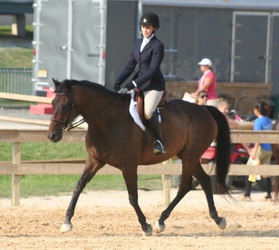
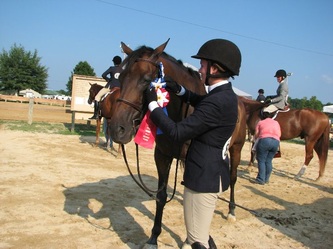
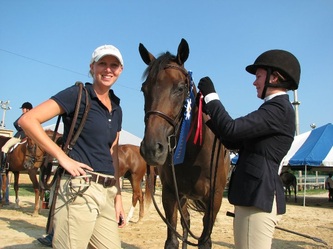
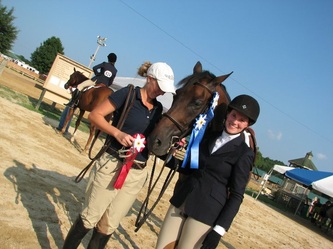

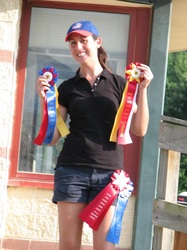
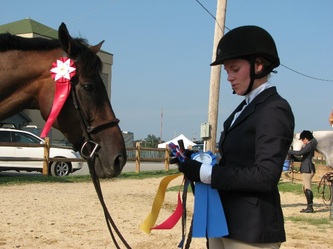
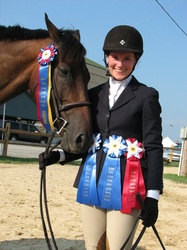
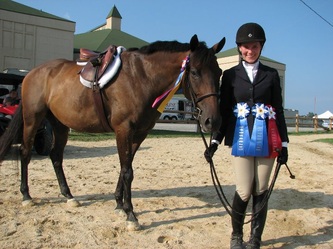
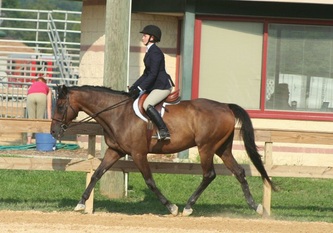
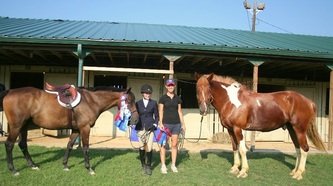
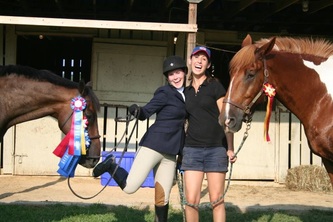
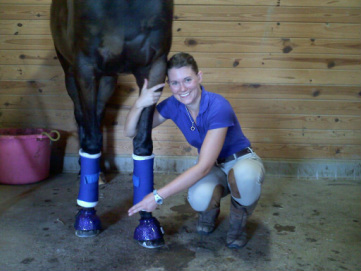
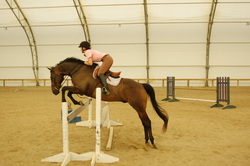
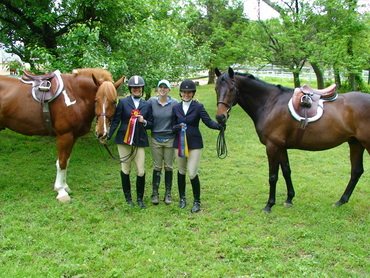
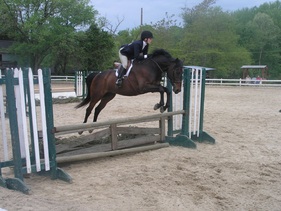
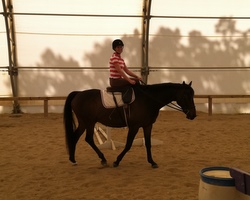
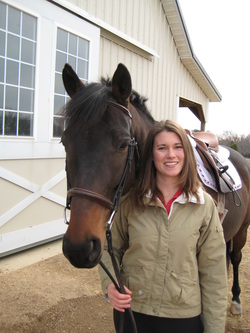
 RSS Feed
RSS Feed